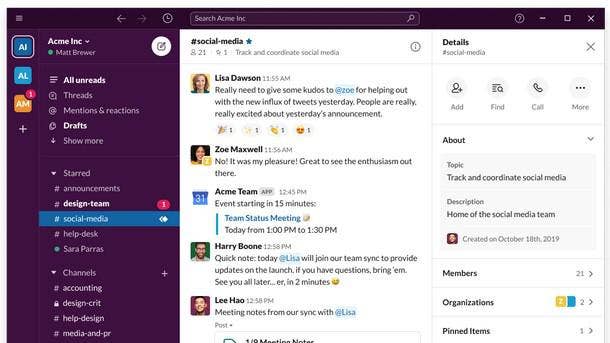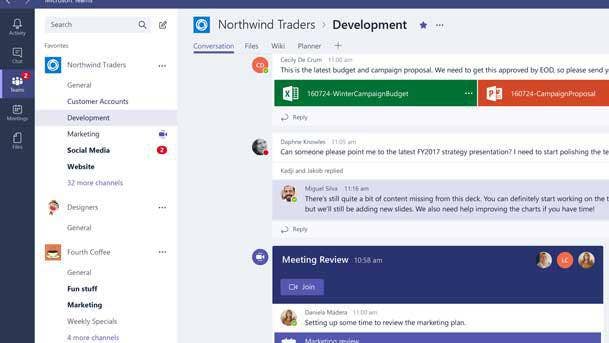10 Top Microsoft Teams News Stories Of 2020
From massive user growth, to feature updates, to partner opportunities, here are the biggest news stories of the year about the Microsoft Teams collaboration platform.

Breakout Year For Teams
Before this year, Microsoft had spent several years refining and heavily promoting its Teams collaboration app. All of that effort paid off during the big shift to remote work in 2020--and Teams is now ending the year in an astonishingly different situation than it started out. Not only is Teams now a household name and used by more than 100 million people each day, but the app itself now has far more functionality than it did at the start of 2020--thanks to a rapid pace of development by Microsoft. Meanwhile, many solution providers in North America have gone all-in on Teams, and found a wide array of revenue and profitability opportunities over and above licensing (which is negligible, since Teams is already part of Office 365). “What’s so attractive with Teams is that there are so many revenue streams for a company like ours,” said David Ellis, vice president of collaboration at Tacoma, Wash.-based Continuant.
What follows is our roundup of the 10 biggest Microsoft Teams news stories of 2020.

10. Microsoft Debuts Separate Windows For Meetings And Calls In Teams
In 2020, Microsoft initiated a rapid pace of development for the Teams collaboration app as users--and expectations--have increased. In particular, Teams received upgrades around its video capabilities, such as the introduction of an “end meeting” button and virtual backgrounds.
Another new feature that rolled out to Teams this year is the ability to pop out separate windows for meetings and calls in the collaboration app. Previously, Teams had restricted users to using a single window within the app at a time. Users get the ability to pop out meetings and calls into separate windows as a way to help “optimize their workflow,” Microsoft said.

9. Slack Files Antitrust Complaint Against Microsoft Over Teams
The growth of Teams led to pushback from one of the app’s biggest rivals, Slack. The company announced in July that it had filed an antitrust complaint against Microsoft with the European Commission. The filing relates to the bundling of Teams with the widely used Office 365 suite. “Microsoft has illegally tied its Teams product into its market-dominant Office productivity suite, force installing it for millions, blocking its removal, and hiding the true cost to enterprise customers,” Slack said in a news release.
Microsoft responded to the Slack complaint to argue that Teams offers a differentiator around video collaboration, which has driven the platform’s strong growth in users. “We created Teams to combine the ability to collaborate with the ability to connect via video, because that’s what people want. With COVID-19, the market has embraced Teams in record numbers while Slack suffered from its absence of video-conferencing,” Microsoft said in a statement. Slack does offer video calling, but has not emphasized the feature to the degree that Microsoft has for Teams. In early December, Salesforce announced an agreement to acquire Slack for $27.7 billion.

8. Microsoft Seeks To Ramp Up Teams Calling With Array Of New Features
Microsoft is pushing forward on the development of new features for Teams Calling as the company seeks to compete more vigorously with existing phone system options. While the Teams collaboration app can be used for VoIP audio calls between Teams users, Microsoft also offers an option to add a full phone replacement within Teams, which uses the Public Switched Telephone Network. In December, Microsoft announced updates both for calling within the Teams app and for the full cloud-based Teams phone system. Key updates include a new “streamlined calling experience”--which brings crucial calling elements such as the dial pad, call history, voicemail, contacts and settings into one central location.
Additional features announced by Microsoft include the ability to save call recordings in OneDrive and SharePoint, CarPlay support, spam identification and call merge. In early 2021, users will also get the ability to transfer calls between mobile and desktop using an interface in the Teams app, Microsoft said.

7. Microsoft Offers Teams For Free
While businesses flocked to Teams as online collaboration became an essential need virtually overnight, one well-timed move by Microsoft in particular helped to jumpstart a significant portion of the growth. Microsoft actively sought to boost Teams usage during the coronavirus outbreak and the resulting rise in remote work: In early March, the company announced it would offer a free Office 365 E1 subscription for six months to businesses and educational institutions that weren’t currently licensed for Teams. The free Teams subscription was “very popular,” Microsoft Channel Chief Gavriella Schuster said in an interview with CRN--driving many businesses to try out, and ultimately opt to stick with, the Teams platform for their collaboration needs.

6. Microsoft Channel Chief Shares The Biggest Teams Revenue Opportunities
As Teams has exploded in usage this year, solution providers have been “central” to the growth and have been finding multiple routes to driving major revenue from Teams, Schuster told CRN. Licensing revenue from Teams is hard to come by, because so many businesses are already licensed to use Office 365. But solution providers have found a wide array of routes to driving revenue by helping customers with Teams—from deployment, to advisory services, to managed services and more, Schuster said in an interview conducted over email with CRN.
“Some companies are using Teams for the first time and need help with that initial deployment and user training,” said Schuster, corporate vice president for Microsoft’s One Commercial Partner organization. “Others may have already made that shift to remote work and are now more focused on how to drive meaningful team collaboration.”

5. Microsoft Launches Together Mode Feature In Teams
Microsoft is seeking to make one of the latest feature additions to the Teams app, Together Mode, into the next big game-changer for video conferencing. Using AI segmentation technology, Together Mode places participants in a video meeting into a shared virtual background. The idea is to make participants feel more like they’re sitting together in the same room.
Together Mode is an improvement because it lets users focus on the body language and faces of other users, according to the company. That makes communication feel more natural and reduces meeting fatigue, Microsoft said.
Microsoft debuted an auditorium scene as the first shared background for Together Mode. In December, the company said it was rolling out additional shared backgrounds including a conference room, coffee shop and classroom.

4. Microsoft Adds 12M Users For Teams In One Week
While it was only the beginning of Teams’ user growth in 2020, a stunning statistic shared by the company on March 19 helped reveal just how critical Teams was becoming as a result of widespread working from home. That day, Microsoft reported that Teams had added 12 million daily active users in just the previous week--up from 32 million on March 11. That also represented a doubling of Teams’ daily active user count from the previous November. At the time, Microsoft CEO Satya Nadella predicted--correctly--that in the following months the world was “going to learn a tremendous amount to transform how we work together.”

3. Microsoft Expands Number Of Visible Video Participants
In 2020, Microsoft addressed one of the biggest limitations for its Teams video calls when compared to other popular video conferencing tools such as Zoom. In the spring, Microsoft rolled out a 3 x 3 grid for viewing nine participants simultaneously--up from four visible participants previously. Teams went on to receive another expansion of its gallery view for video calls, enabling Teams video for up to 49 visible participants. Crucially, moving to a 49-person gallery view option brought Teams to parity with Zoom.

2. Partners Find Growth Providing Secure, Optimized Teams Deployments
A number of solution provider executives recently spoke with CRN about the opportunities they have found to grow their businesses with Microsoft Teams. At Tacoma, Wash.-based Continuant, revenue related to Teams is expected to surge by up to 50 percent in 2020 compared with last year. The solution provider often starts off by holding business case workshops before moving into design and deployment. Recurring revenue can stem from managed services and from ongoing services around adoption and change management, Continuant executives told CRN.
At New York-based Logicalis U.S., the revenue opportunity from Microsoft Teams professional services such as governance has been massive, said Tim Beamer, senior solutions architect for Logicalis U.S. Governance includes ensuring that roles, permissions, user capabilities and third-party connections are set up in an ideal and secure way for the customer. “That governance piece becomes really critical, and if you get that right, the Teams environment just works a lot better,” he said.
Meanwhile, security is a top priority with the emergence of Teams as a central hub for work—creating additional services opportunities for many solution providers. Security is “a great use case where we see an ability to generate revenue from Teams,” said Matt Dierolf, enterprise architect at Blue Bell, Pa.-based Anexinet. For the solution provider, revenue opportunities have included consulting services to implement Teams security for customers, as well as recurring revenue from managed services to stay on top of security controls.

1. Teams Surges To 115M Daily Users
In one year, Microsoft’s Teams collaboration app grew its user base by nearly 6X. In November 2019, Microsoft reported 20 million daily active users for Teams. By mid-March 2020 that figure had reached 44 million--and by late October 2020, daily active users of Teams had surged to 115 million. “As companies move online, they also want one unified platform--from meetings to phone systems--which Teams delivers,” Nadella said in October.
The readiness of partners to help deploy Teams is a leading example of how Microsoft’s emphasis on shifting to cloud positioned the company and its partners to respond during the COVID-19 crisis, Schuster told CRN. “We’ve been working toward this,” she said – “even though we had no idea” what exactly was coming.
“If you look for a silver lining, it is that I think our partners were very well prepared. A lot of the solutions that we’ve been working on helping them build fit well into what customers need right now,” Schuster said.